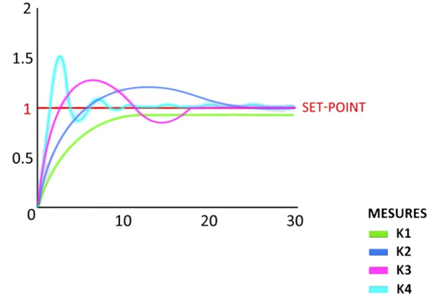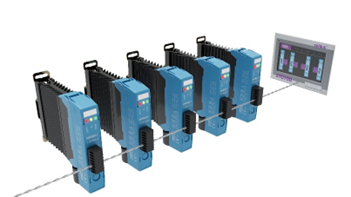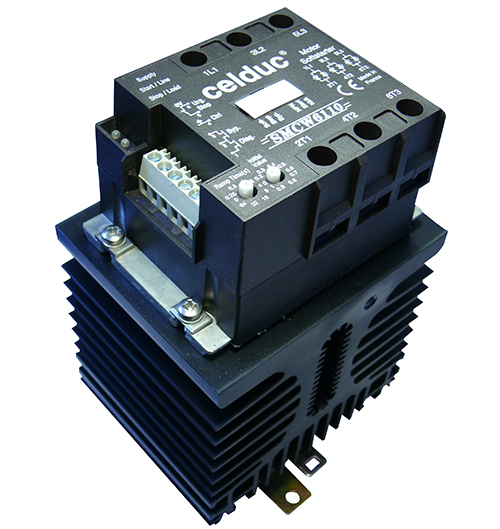Blog - EXPERTISE & INNOVATIONS - Solid State Relays - Solid State Relays with special functions
Solid-State Relays (SSRs) are electronic switching devices that control power to electrical loads. Unlike traditional electromechanical relays, which use physical contacts to open and close circuits, SSRs rely on semiconductor components (such as TRIACs, thyristors, or MOSFETs) to perform the switching function. These components enable the SSRs to operate silently and with greater precision.
Want to know more the advantages of Solid State Relays (SSR) over Electro-Mechanical Relays (EMR) => please watch our tutorial video : https://youtu.be/gIHwjhxVYQ8
SSRs play a critical role in modern manufacturing processes, improving efficiency, safety, and reliability.
In summary, SSRs offer a more reliable, efficient, and long-lasting solution compared to traditional electromechanical relays, especially in demanding industrial applications where precision, durability, and low maintenance are key factors. Furthermore, SSRs offer some special functions that could help improve your manufacturing process. In this new blog article we will introduce you to celduc’s innovation in SSR technology and how this product range offers special embedded features tailored to your industrial needs.
celduc SSRs integrate advanced diagnostic and monitoring capabilities to enhance the performance and reliability of manufacturing processes. These built-in features allow operators to continuously monitor the status of the load, the relay output and the network, providing real-time feedback on important parameters. By detecting potential issues early—such as overheating, overcurrent, or SSR in short-circuit—Celduc SSRs help prevent costly downtime and equipment damage. The diagnostic functions can alert users to faults or irregularities, enabling a quick response and minimizing the impact of unexpected failures.
Here are our SSR product ranges :
These special functions are recommended for applications where the monitoring of production equipment is required to minimise expensive downtimes, such as :
PID temperature controllers are vital components in precise temperature control systems.
SSRs with PID temperature controller are designed to provide precise temperature control in industrial processes. These relays use built-in sensors and control algorithms to maintain the desired temperature levels by adjusting the output to the load condition.
Working principles of Temperature Regulation: In applications like ovens, furnaces, or heating elements, the SSR continuously monitors the temperature of the system through embedded sensors. When the temperature reaches a predetermined setpoint, the SSR adjusts the power output to the heating element, either reducing or cutting off power to maintain the desired temperature. If the temperature starts to rise or fall outside the acceptable range, the SSR can take corrective action, such as turning the heat up or down in real-time, to ensure precise thermal control. This helps prevent overheating or underheating, which could affect product quality or energy efficiency.
Temperature regulation improves the accuracy and consistency of industrial processes and enhances energy efficiency. This is especially valuable in industries where precise temperature and power control are critical, such as plastics manufacturing, food processing, and chemical production.

Our ECOM module integrates a thermocouple for measuring temperature. An Insulated input is available for thermocouples type J, K, T, E.
Logic outputs OUT1 and OUT2 of the ECOM module can be used for heating and cooling.
The PID is available with automatic or manual tuning :
Automatic tuning ensures that the controller will always be active and will constantly analyse the different setpoint-process (error). If this difference is greater than the value set on parameter 7 (Max Gap Tune), the ECOM will determine when and how to modify the PID parameters so as to get back in compliance with the target setpoint
The manual procedure allows the user a greater flexibility on deciding when to update the PID algorithm parameters.
The applications are mainly in industries where precise temperature and power control are critical, such as plastics manufacturing, food processing, and chemical production.
Case Study 1: Manufacturing Industry A manufacturing plant uses our SUL solid state relays with pluggable ECOM module to maintain precise temperatures in their extrusion process. The SSRs provide reliable switching, ensuring consistent product quality.
Case Study 2: Chemical Processing In a chemical processing facility, SUL solid state relays with pluggable ECOM module are used to regulate the temperature of chemical reactors. The precise control provided by the PID controllers ensures optimal reaction conditions, leading to higher yield and product quality.
The role of communication interfaces in SSRs is to enable seamless integration and communication between the SSR and other components of the manufacturing system, such as programmable logic controllers (PLCs), supervisory control and data acquisition (SCADA) systems, or remote monitoring devices. These interfaces are essential for enhancing automation, improving system coordination, and enabling real-time monitoring and control.
Integration with Automation Systems: Communication interfaces allow SSRs to be incorporated into larger industrial automation systems. For example, an SSR can communicate with a PLC to receive commands, feedback, or status updates. This allows for centralized control of multiple devices and systems, reducing the need for manual adjustments and improving the overall efficiency of the manufacturing process. The SSRs can automatically adjust their settings based on input from the PLC, optimizing the operation in real-time.
Remote Monitoring and Control: With built-in communication interfaces, SSRs can transmit data to remote monitoring systems. This enables operators to track critical parameters such as load status, SSR status, temperature, …. In case of any irregularities, alerts can be sent to operators, allowing for immediate corrective actions to be taken before any damage or significant downtime occurs.
Enhanced Troubleshooting and Diagnostics: Communication interfaces make it easier to diagnose issues remotely. SSRs with communication capabilities often feature diagnostic functions that can transmit error codes, fault conditions, and system statuses back to a central system. This reduces the time spent on troubleshooting by providing operators with precise information about what’s wrong, allowing them to quickly identify and resolve the issue.
Integration with Smart Factories and IoT: As manufacturing processes become more advanced and connected through Industry 4.0 principles, communication interfaces in SSRs enable integration with IoT devices and smart factory systems. This allows for highly automated, data-driven operations, where devices communicate with each other and the central system for continuous optimization and improved decision-making.
In summary, the communication interface in SSRs plays a pivotal role in enabling smart manufacturing, improving efficiency, supporting remote control and monitoring, and fostering seamless integration with other systems.
Our ECOM allows a Real-time monitoring via an RS485 link and MODBUS RTU protocol.
Modbus RTU is an open serial protocol derived from the Master/Slave architecture originally developed by Modicon (now Schneider Electric). It is a widely accepted serial level protocol due to its ease of use and reliability. Modbus RTU is widely used within Building Management Systems (BMS) and Industrial Automation Systems (IAS).

Direct control is possible by HMI or a PLC with MODBUS RTU protocol.
Other communication protocols are possible (e.g. Ethernet IP, Ethercat, Profinet…) through a Modbus RTU converter Gateway.
The typical applications are in industries that rely on remote diagnostics and centralized control, such as energy, HVAC, or water treatment plants.
SSRs with power regulation capabilities adjust the amount of power delivered to a load based on real-time conditions. Instead of turning the power fully on or off, these SSRs use techniques like phase control or proportional control to modulate the power output in a controlled manner. This ensures that the power supplied is always at the optimal level required by the system, preventing power surges, improving energy efficiency, and reducing wear on components.
celduc® relais offers a wide range of controllers with various control modes and input types.
Types of input control: 0-10VDC, 4-20mA , potentiometer or PWM (Pulse Width Modulation).
3 control modes are available:
A technology for every application!
In summary, SSRs with analogue control are essential for applications that require precise, smooth, and efficient regulation of power. They offer significant advantages in energy savings, equipment longevity, and process stability, making them crucial for maintaining high-quality standards in modern industrial manufacturing processes.
Unlike traditional SSRs, which operate in a simple on/off manner, SSRs with proportional control modulate the output depending on the required demand, making them ideal for applications where precise regulation of power is essential.
SSRs with burst control mode are used for controlling resistive loads with low thermal inertia, such as short wave infrared emitters (infrared heater bulbs).
SSRs with Full wave pulse control mode are suitable for high inertia loads (industrial furnaces, etc.).
Finally, SSRs with phase angle control are adapted to loads that rapidly react when faced with voltage variations (lamps, motors, etc.). Also for DC loads behind a rectifier bridge (heater wires, Peltier effect modules, etc.).
The soft start functionality in SSRs (Solid-State Relays) refers to the ability of the relay to gradually ramp up power to a load, such as a motor or incandescent / infrared lamps, instead of applying full power instantly. This helps to prevent sudden electrical surges or mechanical stress, which can cause damage to the equipment, reduce its lifespan, and create operational inefficiencies.
How Soft Start works in SSRs:
During the start-up phase, when the equipment (such as a motor) is powered on, the SSR doesn’t immediately apply full power. Instead, it gradually increases the power over a predetermined period.
In the case of motors or other mechanical devices, a softstarter prevents the motor from drawing a large inrush current that could cause damage to the motor windings or the electrical infrastructure (effective reduction of torque and starting current).
For incandescent or infrared lamps, this helps in reducing inrush current and , as a result, increasing their service life.
celduc® relais offers a range of three-phase AC softstarters : SMCV / SMCW range.

Softstarters are used in industries using motors, conveyors, or pumps—anywhere mechanical equipment could benefit from reduced wear and tear.
celduc’s SSRs with special functions contribute to enhanced reliability, efficiency, and control in manufacturing processes.
celduc is able to offer a wide range of product functionality thanks to its commitment to quality and innovation in SSR design.
Take advantage of our many benefits by considering celduc SSRs for your next manufacturing project, either by contacting our sales & technical team for more information or by exploring specific products on your own.